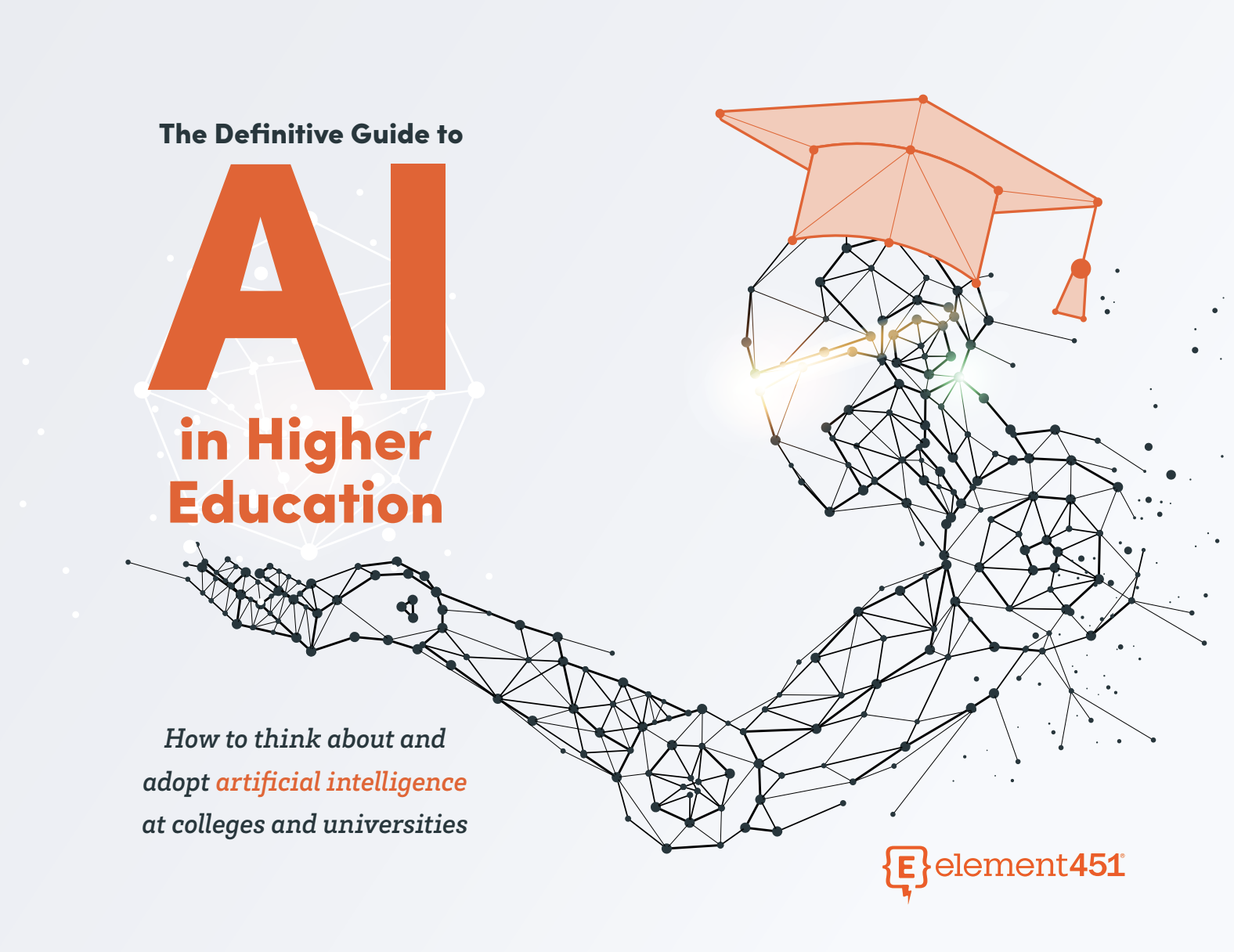Declining Enrollment at Community Colleges | Element451
by Josh Schwartz, Ed.D. · Updated Sep 13, 2024
Community College Declining Enrollment—Is it Still a Problem in 2024?
There’s been much conversation in higher education about declining enrollment. Enrolling fewer students is a concern for all types of institutions, regardless of whether they’re public, private, or community. And post-pandemic, most four and two year colleges are still hoping for a rebound on admissions numbers.
As pillars of locally accessible postsecondary education, how do enrollment trends affect community colleges? For schools that have had difficulty attracting and recruiting new students, is there anything that can be done to reverse troubling trends?
In this post, we’ll discuss the newest data, how you can address enrollment gaps or fewer students, and strategies for driving more enrollment in a competitive market.
Why is Community College Enrollment Important to Higher Ed?
The local community college continues to play a vital role in the United States, despite the numerous options students have when it comes to pursuing degrees after high school. With shorter degree completion times and affordable options, community colleges act as a practical bridge between students and future careers or more advanced degrees.
There are other reasons why community colleges are still influential in a crowded higher education market. These include:
- Affordability – When compared to the average cost of a four-year institution, many community college students have more budget-friendly options and can save on attendance or living expenses.
- Availability of Associate degrees – After completing a two-year academic program, community college students can earn Associate degrees that enable them to begin a job path or transfer credits to four year institutions.
- Certification for career or vocational roles – Many colleges join forces with vocational programs to offer students practical on-the-job training.
State of Community College Enrollment in the United States
Despite the value of community colleges to both students and faculty, recent trends have shown a mixed bag of results. The Associated Press describes this as a “reckoning” for two year community colleges, which often have fewer resources for marketing and recruiting but also lower completion rates among enrolled students.
Declining Trends—What Does Enrollment Data Really Say?
One recent enrollment report shows that “community college enrollment has plummeted by nearly two-fifths since 2010, a staggering decline in a sector with the potential to offer the greatest value in American higher education.”
In other words, the community college system is designed to support local communities, but low retention rates bring that potential down.
Recent enrollment numbers also appear in the context of political movements designed to support the community college system as foundational to American higher education. Even with movements to offer free community college to more Americans, the system is hardly perfect.
What are the Implications for Students?
Community colleges have the potential to become a true pathway to higher education and career opportunities for underserved student populations and minority populations, including Black and Hispanic students and some mid-career adult learners. According to recent reporting coverage from The Hill:
“Community colleges have always had a reputation as an affordable degree for students in unique circumstances who might not be able to swing a four-year institution but still want a good-paying job, positions that often require at least some higher education in the modern market.”
Eliminating the community college dream (or watching as it continues to flounder) may be a costly mistake for millions of Americans who need and want a proven college education.
Positive Growth Potential
While the trends might look bleak, there are a few reasons to have faith in the longevity of community institutions. For starters, Axios released 2022-2023 enrollment numbers that indicated a positive 0.5% uptick in community college applications over a one year time period. Some of these advancements are degree-specific, with Computer and Information Services (IT) and mechanical fields ranking highly among enduring programs that attract new students.
Additionally, there’s more light on the horizon. As reported in Inside Higher Ed, the National Student Clearinghouse research Center released its report on the state of undergraduate enrollment in 2023. The report indicates that enrollment declines have mostly paused, and community college vocational programs are giving more students and local residents reason to sign up.
Another reason to maintain hope? As labor markets heat up, students take advantage of opportunities to enroll outside of four year schools. To capitalize on this new interest, community college leaders must market to desirable skills and job interests.
Factors that Contribute to Enrollment Trends
Many enrollment fluctuations are natural and predictable based on broader cultural trends and shifts in society. Outside influences like the economy, generational trends, and job availability or scarcity tend to impact enrollment numbers for all types of institutions.
Which trends have a specific and documented impact on community college enrollment? Let’s take a closer look at how external factors drive enrollment trends—for better or worse.
Rising Cost of Tuition and Fees
Increased educational costs often deter students from attending schools, even in community colleges. But that’s not to say that community-based institutions aren’t affordable. According to The Hill, the average in-state tuition for a community college student is around $3,800 per year, whereas private school students might pay up to $40,000 annually at large private institutions.
Financial impacts on low-income students are often more serious than they are for students from wealthier socioeconomic backgrounds. Additionally, the more difficult it is for low income students to both locate and take advantage of financial resources (in the forms of grants, loans or scholarships), the harder it is for them to actually attend school.
Misconceptions and Lack of Awareness
Believe it or not, even in modern education there are plenty of misconceptions about community colleges and the journey to an associate degree. And although 8.2 million college-aged students attend a community institution, many others don’t know what options are available at the local level.
A few common myths about the community college experience include the following.
- Community college degrees are less desirable for employers
- Educational performance is easier at community colleges because the courses are less intense
- Faculty and adjunct professors aren’t as qualified to teach
- The community college setting is only for technical or trade-based
While these rumors aren’t true, they do have the potential to sway student decisions. That’s why it’s so important for schools to focus on clear, persuasive marketing messages that resonate with potential students. The many benefits of attending far outweigh most of the fears and concerns that prospective students have.
Availability of Vocational Roles
As first-time enrollment numbers trend downward, the Hechinger Report has taken an in-depth look at why community colleges are registering fewer students than in decades prior. One of the main reasons? Low-income students are turning to vocational openings that provide an immediate paycheck to keep themselves afloat.
Although the financial benefits of earning a college degree are significant, they’re also long-term—often about two to four years after earning a degree. For students that work to support their families or even act as caregivers, delaying full-time work until after degree attainment is too challenging.
Despite the fact that community colleges offer flexible course schedules and evening classes, many students work long hours or overnight shifts to support their families.
4 Strategies to Reverse the Declining Enrollment Trend
Despite the (very real) concerns at many community colleges, school leaders and administrators shouldn’t despair entirely. Community schools will continue to provide essential learning steps, particularly for those seeking Dual Enrollment courses as high school students. Recognizing the unique needs and qualities of this target market is key to helping enrollment numbers tick upward.
1. Personalize the Marketing and Enrollment Approach
Regardless of degree choice, modern college students have high expectations for making connections in the enrollment process. They’re more likely to research academic offerings digitally, and they crave marketing material that’s relational and customized.
A student engagement platform like Element451 gives schools the tools they need to deliver timely, personalized content that’s unique to specific student journeys. A student-first approach takes into account the reminders, deadlines, and personal attention that students need to help them enroll.
Effective marketing and branding strategies are also just as critical for community colleges as they are at other institutions. The “do more with less” philosophy hits hard on this point, because community colleges may not have vast marketing teams or extensive budgets to spend on advertising. Turning to an all-in-one CRM platform reduces some of these bottlenecks and makes marketing campaigns easier to create and manage.
2. Offer Financial Aid and Scholarship Opportunities
Financial aid programs and scholarship opportunities might look different at the community level than they do for large scale institutions, but that shouldn’t stop students from applying to community college enrollment.
Based on data from ThinkImpact, roughly 33% of students in community college have received a Pell Grant (a form of federal assistance) in the past decade. Plus, all community college students attending at least part-time are eligible to submit the FAFSA to predict their student loan eligibility.
From a high-level perspective, community colleges are dependent on public funding, perhaps even more than large state schools or public institutions. That’s why advocacy for public funding is so important and vital to the longevity of the community college system.
3. Develop Enhanced Career Programs and Partnerships
Community colleges can more effectively reach their target audience by promoting the development of programs aligned with local job market needs. This is an especially useful tactic if the college is connected to local businesses, corporations, and other regional organizations that can offer students special skills or apprenticeships.
Industry partnerships and internships not only appeal to students who crave real-world experience, but they also enhance student outcomes over time. When students have the ability to apply what they’re learning in actual scenarios, degree attainment is more realistic.
4. Improve Student Support Services
Comprehensive student support services might include student programming related to:
- Academic support
- Financial aid office
- Community college research center
- Peer mentorship and tutoring
- Academic advising services
- Counseling and mental health resources
Long-term student success and retention depends on having access to these invaluable connections. And although community colleges aren’t serving hundreds of thousands of students at one time, investing in the resources to reach a smaller local community is essential. Community colleges should market these offerings as they seek to recruit and attract a new generation of learners to campus.
Solve Real-World Challenges at Community College
When staff at Maryland Community College (MCC) started to witness decreasing enrollment numbers and lower community college student engagement, they recognized the need to act swiftly. But with limited personnel and resources, MCC also recognized the need to introduce smart automations in their workflow to reduce repetitive tasks and free up more time for student-focused activities.
By segmenting their audience, automating email messaging and branded communications, and incorporating student-friendly text message tactics, MCC successfully reversed troubling enrollment trends. Check out a snapshot of their results:
“MCC's enrollment numbers have steadily increased since 2016…Thanks to personalized communication, prospective students are now more informed about relevant MCC programs and receive timely communication resulting in a higher level of engagement.”
Taking action results in the ability to see new hope on the horizon, and take it from us—the results are just as incredible for community colleges as they are for large public institutions.
Increase Community College Enrollments with Element451
Still finding your footing after pandemic-related enrollment dips? At Element451, we join forces with many different types of institutions to attract ideal students and watch as registrations climb.
With a powerful and customizable student engagement platform, Element451 delivers a new way to support recent high school graduates and future community college students. Let’s grow—together.

About Element451
Boost enrollment, improve engagement, and support students with an AI workforce built for higher ed. Element451 makes personalization scalable and success repeatable.
Categories
New Blog Posts

The Definitive Guide
AI in Higher Education
Bridge the gap between the latest tech advancements and your institution's success.
Useful Links
Related Articles

Talk With Us
Element451 is the only AI Workforce Platform for higher education. Our friendly experts are here to help you explore how Element451 can improve outcomes for your school.
Get a Demo








